

Quantum Computing. Quantum Biology. Quantum Biology. Physicists May Have Evidence Universe Is A Computer Simulation. Physicists say they may have evidence that the universe is a computer simulation.
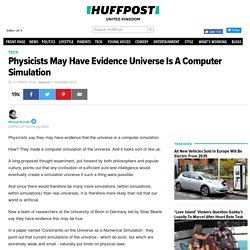
How? They made a computer simulation of the universe. And it looks sort of like us. A long-proposed thought experiment, put forward by both philosophers and popular culture, points out that any civilisation of sufficient size and intelligence would eventually create a simulation universe if such a thing were possible. And since there would therefore be many more simulations (within simulations, within simulations) than real universes, it is therefore more likely than not that our world is artificial. Weird Quantum Tunneling Enables 'Impossible' Space Chemistry. A weird quirk of quantum mechanics is allowing a chemical reaction thought to be impossible to occur in cold gas in outer space.

In the harsh environment of space, where the temperature is about minus 350 degrees Fahrenheit (minus 210 degrees Celsius), scientists had thought a certain reaction involving alcohol molecules couldn't take place, because at such low temperatures, there shouldn't be enough energy to rearrange chemical bonds. But surprisingly, research has shown that the reaction occurs at a rate 50 times greater in space than at room temperature. Now, by simulating the conditions of space in a laboratory, scientists have found a possible explanation for how the reaction occurs: quantum tunneling.
Tunneling depends on the odd rules of quantum mechanics, which state that particles don't usually have decided states, positions and speeds, but exist in hazes of probability. Hubble Quiz: Do You Know the Famous Space Telescope? Quantum black hole study opens bridge to another universe. Simulations back up theory that Universe is a hologram. Artist's impression by Markus Gann/Shutterstock At a black hole, Albert Einstein's theory of gravity apparently clashes with quantum physics, but that conflict could be solved if the Universe were a holographic projection.
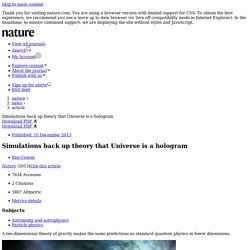
A team of physicists has provided some of the clearest evidence yet that our Universe could be just one big projection. In 1997, theoretical physicist Juan Maldacena proposed1 that an audacious model of the Universe in which gravity arises from infinitesimally thin, vibrating strings could be reinterpreted in terms of well-established physics. The mathematically intricate world of strings, which exist in nine dimensions of space plus one of time, would be merely a hologram: the real action would play out in a simpler, flatter cosmos where there is no gravity.
“It seems to be a correct computation,” says Maldacena, who is now at the Institute for Advanced Study in Princeton, New Jersey and who did not contribute to the team's work. Is The Universe A Hologram? Physicists Say It's Possible. Quantum Biology. The Spooky World Of Quantum Biology. Michael Garfield The new science of quantum biology is teaching us about how the actual behavior of evolution is governed by disconcertingly spooky processes – time travel being one of them.
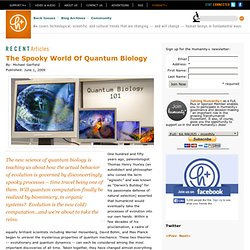
Will quantum computation finally be realized by biomimicry, in organic systems? Evolution is the new (old) computation...and we're about to take the reins. One hundred and fifty years ago, paleontologist Thomas Henry Huxley (an autodidact and philosopher who coined the term “agnostic” and was known as “Darwin’s Bulldog” for his passionate defense of natural selection) asserted that humankind would eventually take the processes of evolution into our own hands. Within a few decades of his proclamation, a cadre of equally brilliant scientists including Werner Heisenberg, David Bohm, and Max Planck began to unravel the mysterious properties of quantum mechanics.
The premise is simple. It’s a promising avenue for people with big plans for strong AI or virtual reality. What does this all mean? QUANTUM JUMPING. Quantum Jumping. Quantum Mechanics Reveals How We Are All Truly Connected - Learning Mind. “I am saddened by how people treat one another and how we are so shut off from one another and how we judge one another, when the truth is, we are all one connected thing.
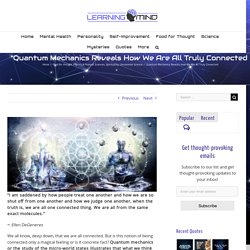
We are all from the same exact molecules.” ~ Ellen DeGeneres We all know, deep down, that we are all connected. Quantum tunnelling. Quantum tunnelling or tunneling (see spelling differences) is the quantum mechanical phenomenon where a subatomic particle passes through a potential barrier.
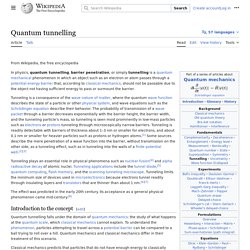
Quantum tunneling is not predicted by the laws of classical mechanics where surmounting a potential barrier requires enough potential energy. Quantum tunnelling plays an essential role in several physical phenomena, such as the nuclear fusion that occurs in main sequence stars like the Sun.[1] It has important applications in the tunnel diode,[2] quantum computing, and in the scanning tunnelling microscope. The effect was predicted in the early 20th century, and its acceptance as a general physical phenomenon came mid-century.[3] Quantum spacetime. In mathematical physics, the concept of quantum spacetime is a generalization of the usual concept of spacetime in which some variables that ordinarily commute are assumed not to commute and form a different Lie algebra.
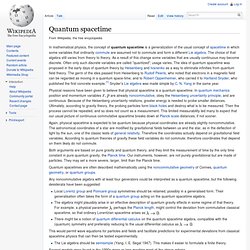
The choice of that algebra still varies from theory to theory. As a result of this change some variables that are usually continuous may become discrete. Often only such discrete variables are called "quantized"; usage varies. Quantum mind. The quantum mind or quantum consciousness hypothesis proposes that classical mechanics cannot explain consciousness, while quantum mechanical phenomena, such as quantum entanglement and superposition, may play an important part in the brain's function, and could form the basis of an explanation of consciousness.
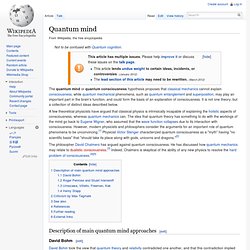
It is not one theory, but a collection of distinct ideas described below. A few theoretical physicists have argued that classical physics is intrinsically incapable of explaining the holistic aspects of consciousness, whereas quantum mechanics can. The idea that quantum theory has something to do with the workings of the mind go back to Eugene Wigner, who assumed that the wave function collapses due to its interaction with consciousness.
The philosopher David Chalmers has argued against quantum consciousness. Description of main quantum mind approaches[edit] David Bohm[edit] Efimov state. The Efimov effect is an effect in the quantum mechanics of Few-body systems predicted by the Russian theoretical physicist V.
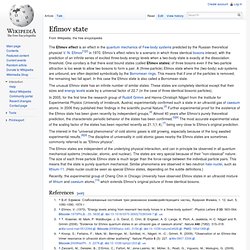
N. Efimov[1][2] in 1970. Efimov’s effect refers to a scenario in which three identical bosons interact, with the prediction of an infinite series of excited three-body energy levels when a two-body state is exactly at the dissociation threshold. Quantum entanglement. Quantum entanglement is a physical phenomenon that occurs when pairs or groups of particles are generated or interact in ways such that the quantum state of each particle cannot be described independently – instead, a quantum state may be given for the system as a whole.

Such phenomena were the subject of a 1935 paper by Albert Einstein, Boris Podolsky and Nathan Rosen,[1] describing what came to be known as the EPR paradox, and several papers by Erwin Schrödinger shortly thereafter.[2][3] Einstein and others considered such behavior to be impossible, as it violated the local realist view of causality (Einstein referred to it as "spooky action at a distance"),[4] and argued that the accepted formulation of quantum mechanics must therefore be incomplete. History[edit] However, they did not coin the word entanglement, nor did they generalize the special properties of the state they considered.